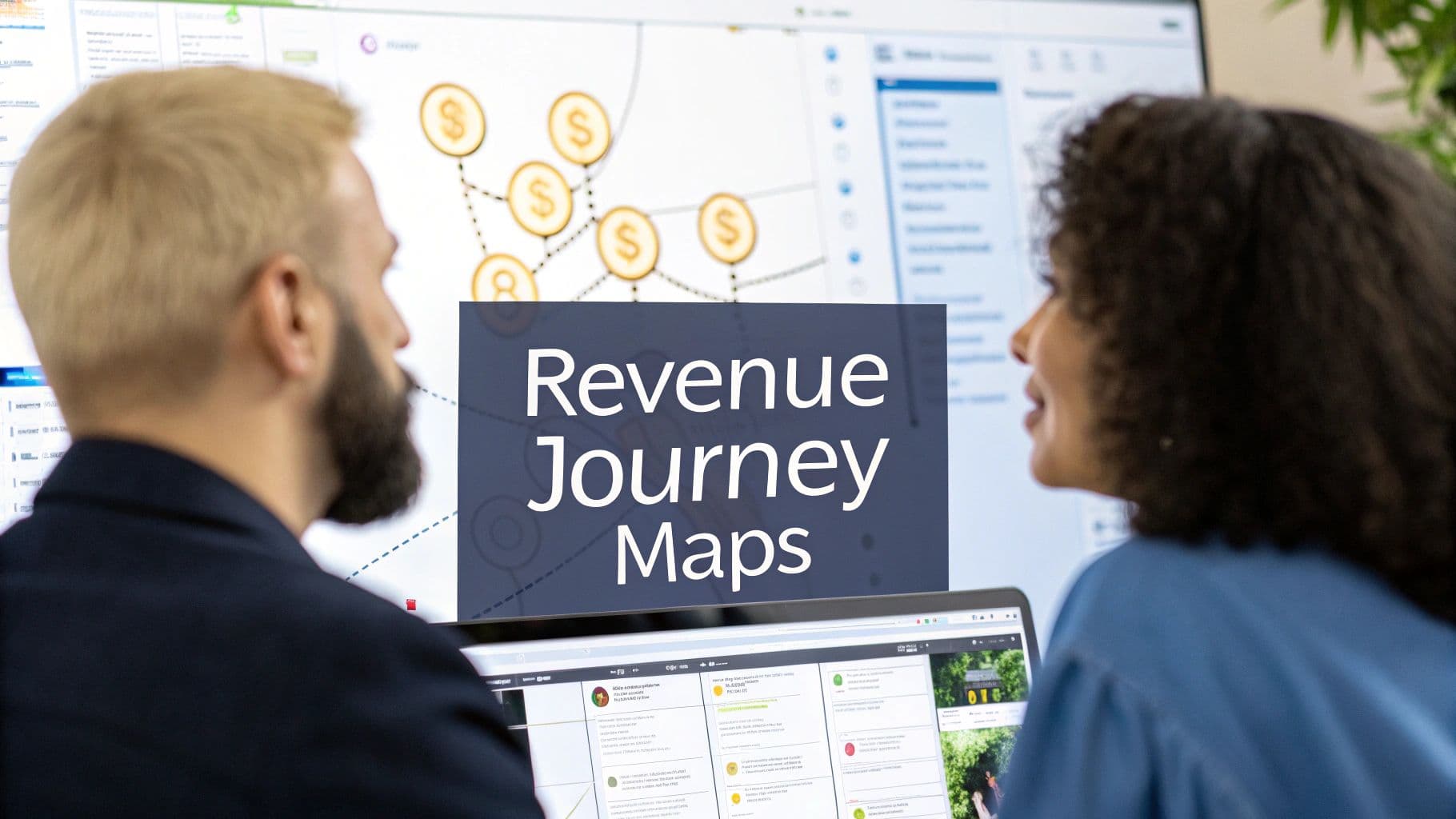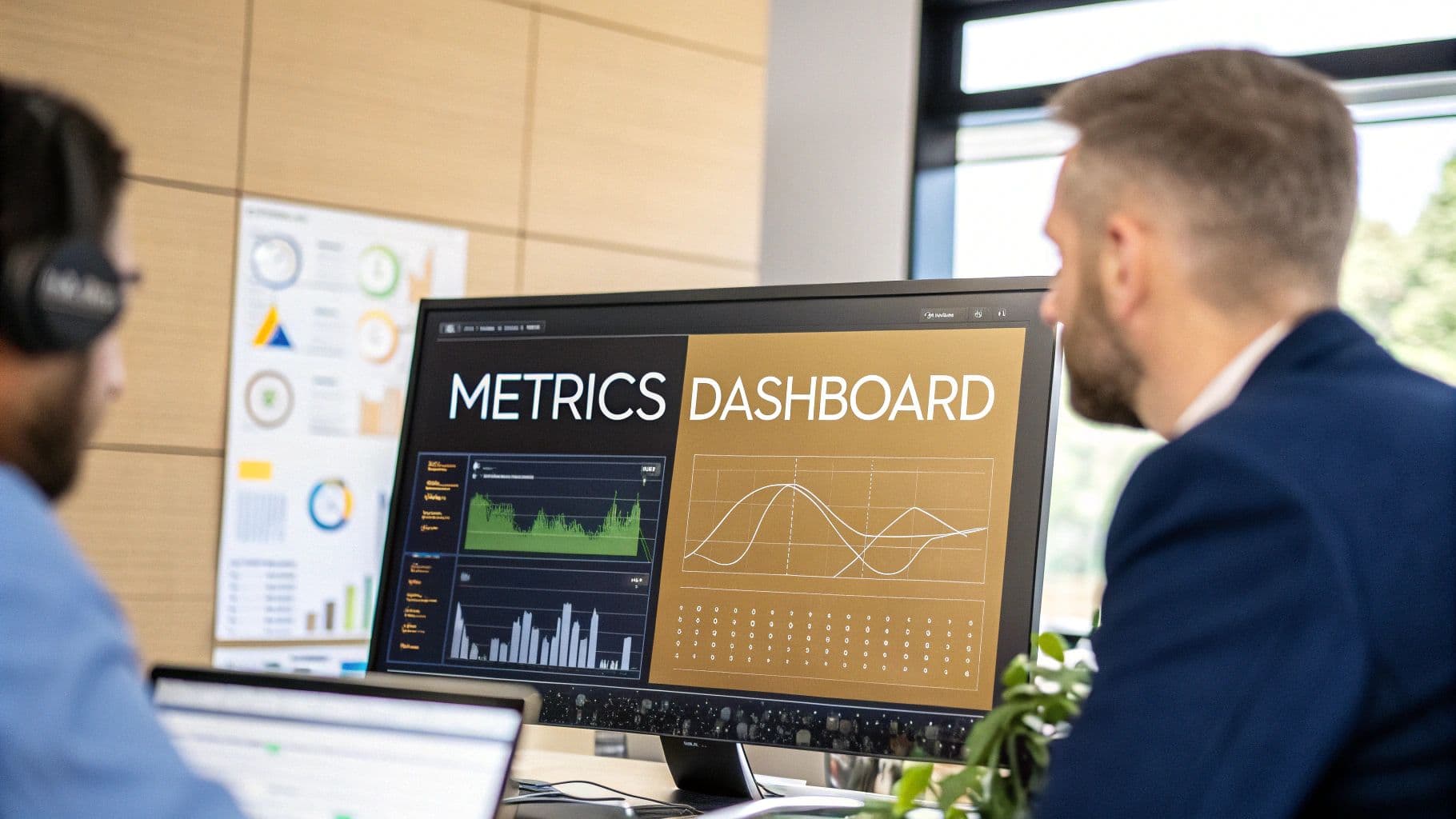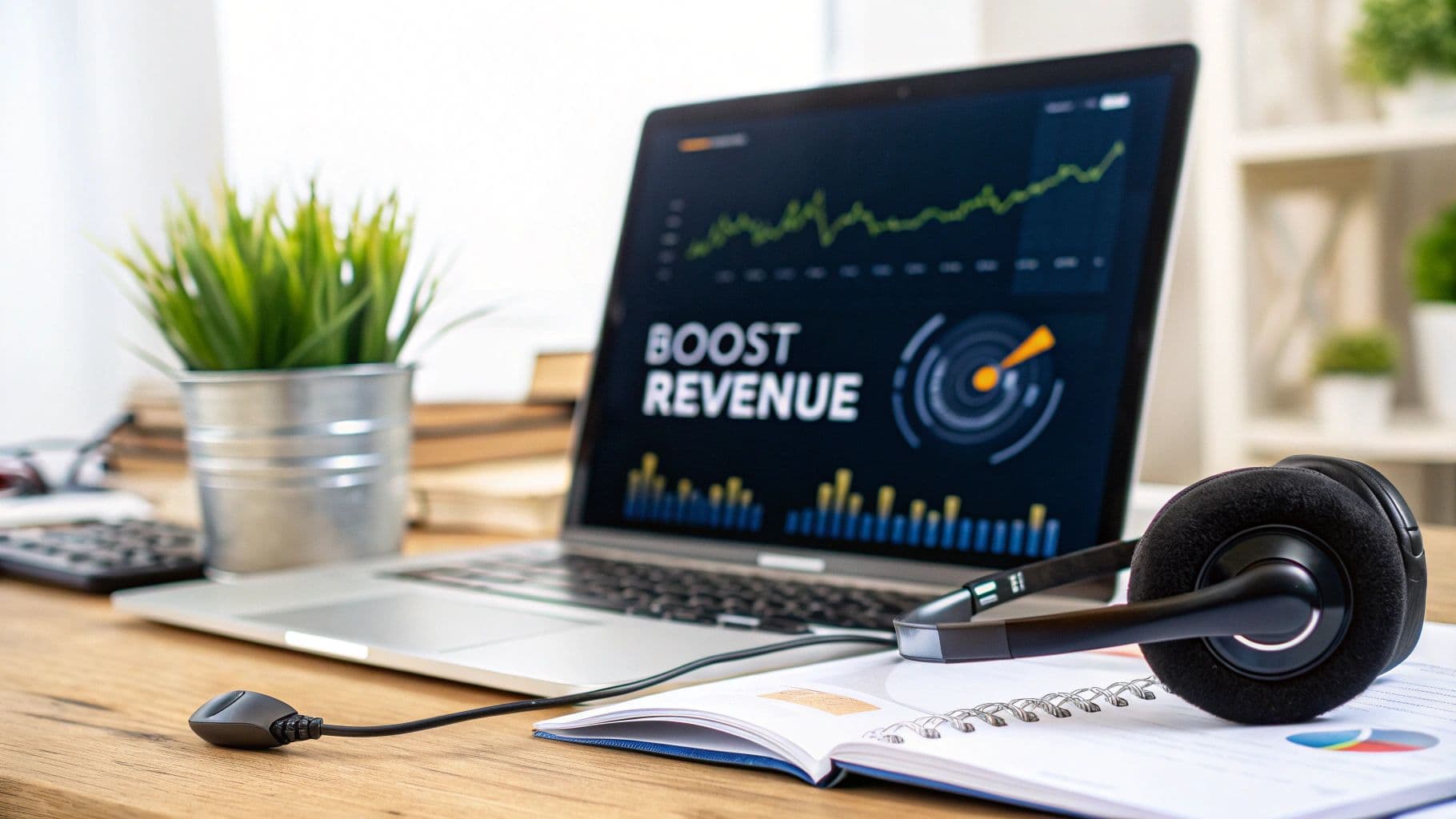AI Powered Decision Making for Modern Business
A guide to AI powered decision making. Learn how AI transforms business data into actionable insights that drive growth and product innovation.

So, what do we actually mean when we talk about AI-powered decision making?
It’s not about handing over the keys to a robot boss. Think of it more like having an expert co-pilot for your business, one that enhances your team's own expertise with incredibly sharp, data-driven insights.
What Is AI-Powered Decision Making?
At its heart, using AI for decisions is about shifting from looking in the rearview mirror to seeing the road ahead. Traditional business intelligence (BI) tools are fantastic at telling you what happened last quarter. AI, on the other hand, is built to tell you what’s likely to happen next—and what you should do about it.
It's like the difference between a pilot's experience and the sophisticated systems in a modern cockpit. A pilot has invaluable intuition and training. But an AI co-pilot can process thousands of real-time data points all at once—weather systems, engine performance, air traffic, fuel levels—to instantly suggest the safest and most efficient flight path. The human pilot still makes the final call, but that decision is now backed by a level of analysis no person could ever do on their own.
From Data to Direction
This completely changes how you work with information. Instead of just staring at data on a dashboard, you can use AI to pick out the meaningful signals from all the noise.
It's the difference between knowing your overall customer churn rate and knowing exactly which customers are at a high risk of leaving in the next 30 days—along with the specific actions most likely to keep them around.
Core Components of AI Decision Systems
This isn't just one magic algorithm. AI decision systems rely on a few key technologies working together, each chosen to solve a specific type of problem.
- Predictive Analytics: This is all about using historical data and machine learning to figure out what’s most likely to happen next. It answers the question, "What's the probable outcome?"
- Prescriptive Analytics: This takes prediction to the next level. It doesn't just show you the future; it recommends concrete actions you can take to influence that future for the better. It answers, "So, what should we do about it?"
- Automation: Once a decision-making model is proven, AI can automatically carry out certain tasks based on the insights, like adjusting ad spend in real-time or flagging a suspicious transaction for immediate review.
To really get a feel for how AI turns simple tasks into intelligent, automated workflows, this guide on AI-powered workflow automation is a great resource. It breaks down how these systems learn and adapt, turning raw information into a powerful strategic asset.
Why Human Intuition Alone Is Not Enough

In a fast-moving market, relying only on your gut is like navigating a storm with an old-school compass. Experience is invaluable, no doubt. But in a world awash with data, even the sharpest intuition has its limits.
The truth is, human judgment is prone to cognitive biases. These are mental shortcuts our brains take that can steer even seasoned leaders in the wrong direction. We’re all wired to look for information that confirms what we already believe and subconsciously ignore data that doesn't fit our narrative.
This is a classic case of confirmation bias. Think of a product manager who is absolutely convinced a new feature will be a smash hit. They might naturally focus on positive feedback while downplaying early red flags in the user data. This is where AI-powered decision making acts as an essential reality check.
The Challenge of Data Overload
Beyond our built-in biases, we face a much more concrete problem: the sheer volume of data. Today, a single business generates a constant flood of information from dozens of sources—support tickets, website clicks, sales calls, social media, you name it.
It's simply not possible for any team to sift through all that information and connect the dots. Important signals get lost in the noise. By the time someone manually spots a pattern, the window of opportunity to act has often already closed.
The market has caught on. By 2025, AI has become a core part of business operations, with roughly 78% of organizations using it in at least one function. That’s a huge leap from 55% just one year before. We're seeing companies move past small experiments and build AI into their core strategies, a trend detailed in Netguru's AI adoption statistics.
Seeing What Humans Miss
AI systems work without emotions or preconceived ideas. They can analyze thousands of variables at once, spotting subtle connections that are practically invisible to the human eye.
Here’s where AI can step in to fill the gaps:
- Spotting Emerging Trends: An AI model can notice a small but growing cluster of support tickets from a specific user group, flagging a potential bug before it blows up.
- Finding Hidden Opportunities: By digging into usage data, AI might discover that a little-known feature is wildly popular with your most profitable customers, revealing a new path for growth.
- Predicting Future Behavior: AI can forecast customer churn with startling accuracy by identifying the subtle behaviors that usually come before a cancellation, giving you a chance to step in and save the account.
Ultimately, pairing human experience with AI-driven insights creates a formidable partnership. It enables you to make decisions that are faster, smarter, and far more objective—the only way to keep up with the speed of modern business.
How AI Empers Product and Growth Teams
For the teams on the front lines of building products and chasing growth, AI-powered decision-making isn't just some high-level theory. It's a hands-on toolkit that helps them hit specific, measurable goals. It's about shifting the focus from drowning in data to taking smart, high-impact actions.
Product and growth teams are constantly swimming in a sea of information. Think of AI as the ultimate filter—it automatically finds the crucial signals in all that noise, pointing directly to the opportunities that actually affect the bottom line. This lets teams move faster and with a whole lot more confidence.
This diagram breaks down the basic flow of turning raw data into a real, actionable decision.
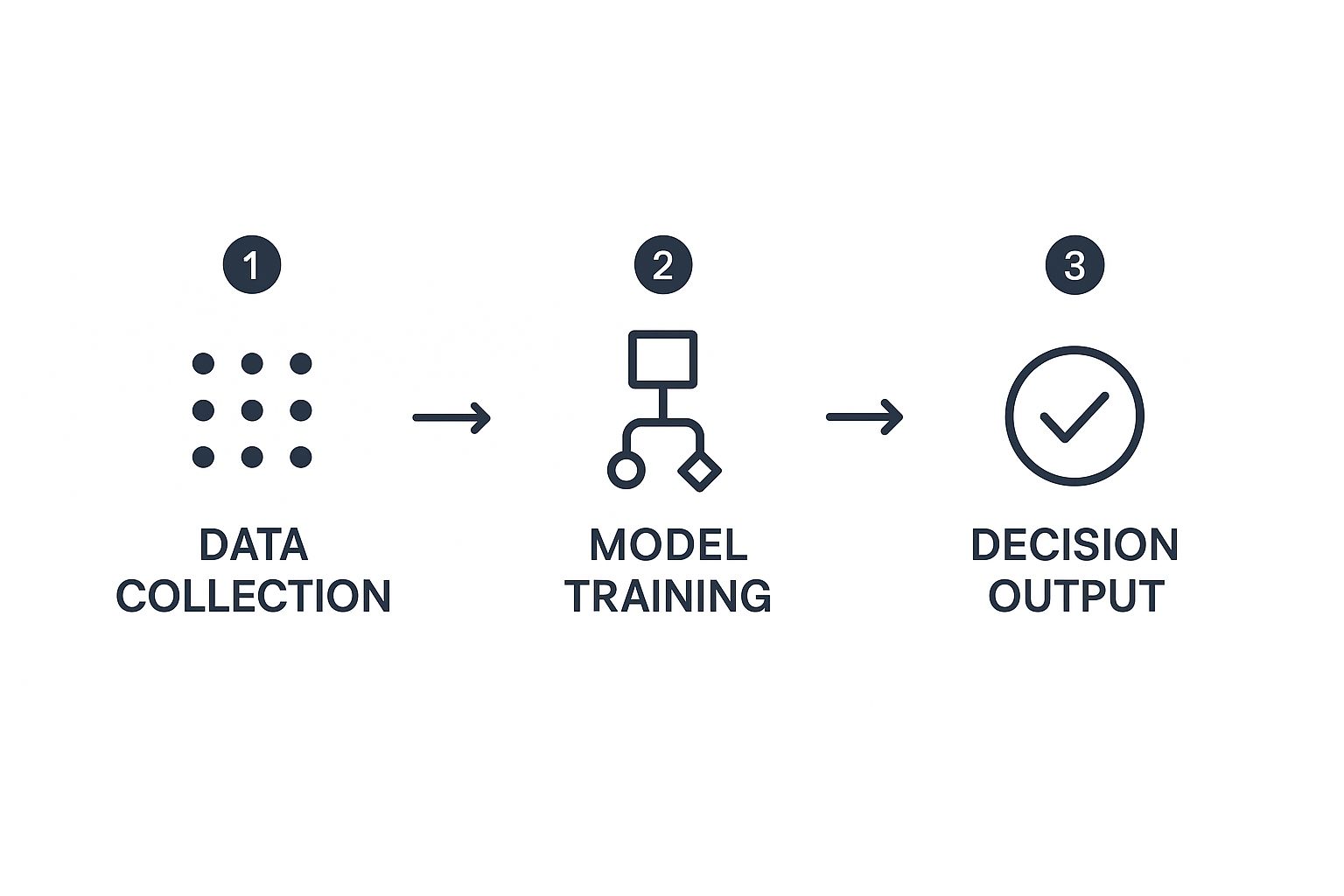
As you can see, AI systems create a smart, repeatable loop. Each decision and its outcome helps refine the model, making future choices even better.
Supercharging Product Management
For product managers, AI delivers the hard evidence needed to build a roadmap that customers will genuinely love and, more importantly, pay for. It elevates prioritization from a gut-feel exercise to a data-backed strategy.
AI models can sift through thousands of support tickets, comb through sales call notes, and analyze user behavior to spot patterns a human would almost certainly miss. This gives product teams some serious advantages:
- Pinpoint High-Impact Features: Discover which new features are most closely tied to customer upgrades or better retention. This ensures precious development time is spent on things that truly move the needle.
- Predict Customer Churn: Identify the specific actions or bug reports that signal a customer is a flight risk, opening up a critical window to step in and save the account.
- Validate Product Direction: Use real, quantitative data to either confirm or challenge assumptions about what users need, dramatically cutting the risk of building something nobody uses.
This data-first approach is at the heart of modern product development. To dive deeper, check out our guide on using AI for product management, which details how to turn customer feedback into your biggest strategic asset.
Accelerating Growth and Marketing
On the growth side, the game is all about delivering the right message to the right person at the perfect moment—and doing it at scale. AI takes this incredibly complex task and makes it a core, automated part of operations. Personalization stops being an aspiration and becomes a reality.
By constantly learning from customer data, AI helps growth marketers graduate from broad-stroke campaigns to truly targeted engagement. Here's what that looks like in practice:
- Dynamic Audience Segmentation: AI can uncover new, high-potential customer segments by spotting subtle behavioral patterns, revealing market opportunities that were completely invisible before.
- Optimized Ad Spend: Machine learning models can predict which ad creatives, copy, and channels will deliver the highest return on investment (ROI), automatically shifting budget to where it will have the biggest impact.
- Personalized User Journeys: AI can tailor website content, email flows, and in-app recommendations for each user in real-time. The result? A massive boost in conversion rates and engagement.
Imagine a visitor from a retail company lands on your website. AI could instantly show them an e-commerce case study. Moments later, a visitor from a bank sees a whitepaper on financial data security. That level of instant, one-to-one personalization for thousands of users just isn't possible without AI.
To really see the difference, let’s compare the old way of doing things with the new, AI-powered approach.
Traditional vs AI Powered Decision Making
The table below contrasts how teams typically handle common business challenges with a more modern, data-driven methodology.
| Business Challenge | Traditional Approach (Intuition-Based) | AI Powered Approach (Data-Driven) |
|---|---|---|
| Feature Prioritization | Relying on the "loudest" customer's request or a senior leader's gut feeling. | Analyzing user data to quantify the potential revenue impact of each feature request. |
| Customer Retention | Reacting to churn after a customer has already canceled their subscription. | Proactively identifying at-risk accounts based on predictive behavioral analytics and intervening early. |
| Marketing Campaigns | Creating broad audience segments based on simple demographics (e.g., industry, company size). | Building dynamic micro-segments based on real-time user behavior and predictive intent signals. |
| Ad Budget Allocation | Manually allocating budget based on last month's channel performance reports. | Automatically shifting ad spend in real-time to the campaigns and channels delivering the highest ROI. |
It's clear that the AI-powered approach doesn't just offer an incremental improvement; it fundamentally changes the speed and accuracy with which teams can operate and win.
Real World Examples of AI in Decision Making
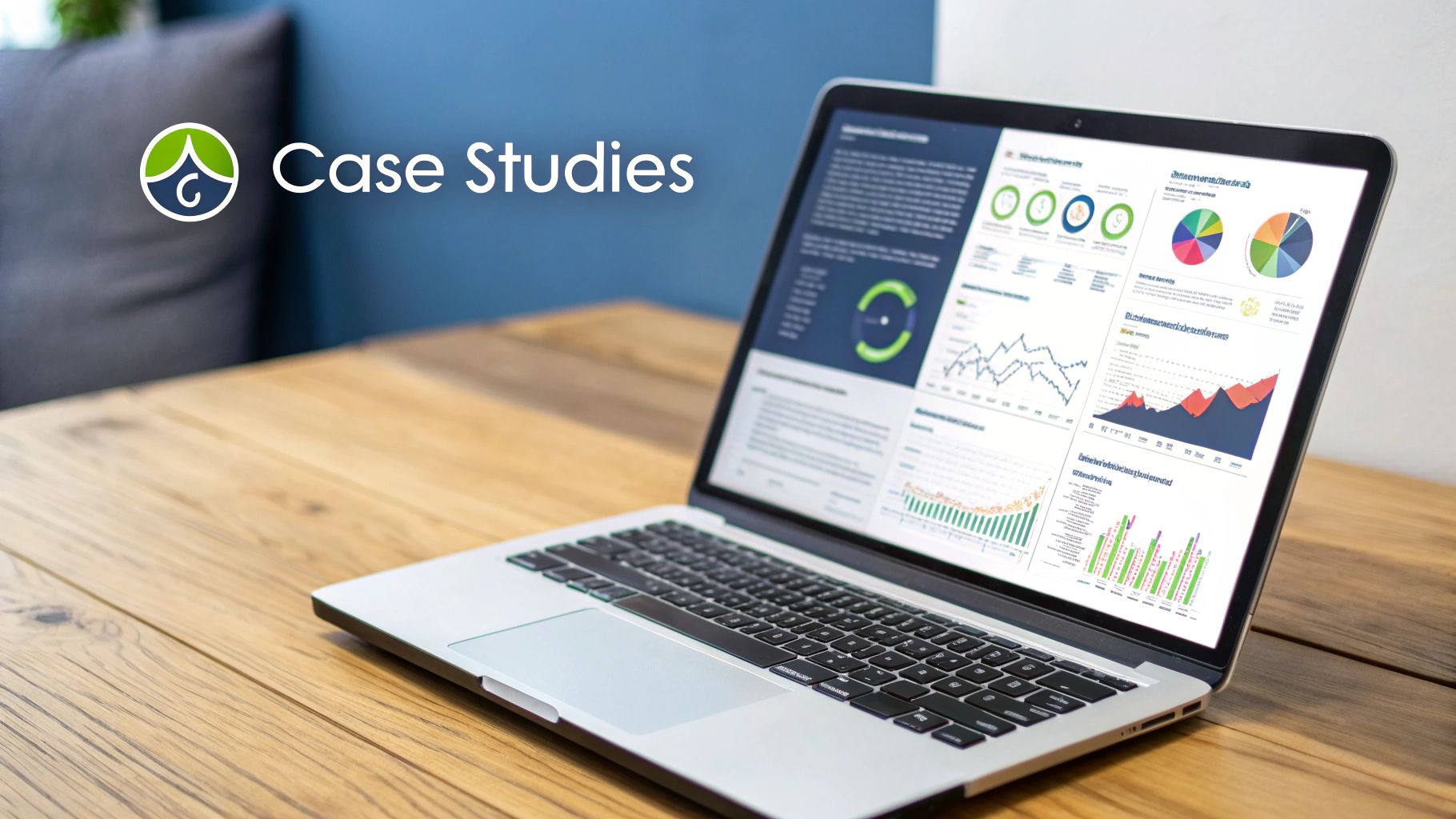
It’s one thing to talk about the theory, but seeing AI-powered decision making in the wild is where it really clicks. Let's step away from the tech giants for a moment and look at some practical, compelling examples from businesses solving real problems every single day.
These stories show how AI isn't some far-off concept. It's a tool being used right now to get measurable results, from untangling complex logistics to protecting billions in revenue.
Dynamic Fleet Management in Logistics
Picture a mid-sized logistics company juggling hundreds of delivery trucks across a major city. Their old system relied on static, pre-planned routes. That worked fine on a perfect day, but one unexpected traffic jam, sudden storm, or last-minute order could throw everything off, leading to costly delays and wasted fuel.
Then, they brought in an AI-driven routing system, and everything changed. The AI constantly chews on thousands of data points in real-time:
- Live traffic patterns pulled from multiple sources
- Weather forecasts and how they’ll affect road conditions
- Vehicle telematics like fuel levels and maintenance alerts
- New delivery requests as they pop up
The system dynamically reroutes drivers to the most efficient path, second by second. The result? A 15% reduction in fuel costs and a 22% increase in on-time deliveries. We're talking about saving thousands of dollars every single day.
Predictive Inventory for E-commerce
An online fashion brand was stuck in a classic retail nightmare: selling out of popular items during peak season while getting buried in unsold inventory of everything else. Their forecasting was based on last year's sales, which is like driving by only looking in the rearview mirror—it just can't keep up with fast-moving trends.
They switched to an AI platform that uses predictive analytics to get a handle on their stock. The model didn't just look at past sales; it analyzed social media buzz, competitor pricing, and even upcoming marketing campaigns.
Figuring out which products will fly off the shelves is a lot like predicting which customers are about to walk away. The underlying predictive technology is quite similar. If you want to dive deeper into how these systems work, check out our guide on building effective churn prediction models.
Real-Time Fraud Detection in Fintech
For a fast-growing fintech startup, manual fraud review was quickly becoming a massive bottleneck. With transaction volume exploding, their small team simply couldn't keep up. This created a double-whammy: they were missing sophisticated fraud while also frustrating legitimate customers with long delays.
By integrating an AI decisioning engine, they could analyze every single transaction in milliseconds. The model was trained to spot subtle, complex patterns that signal fraud—behaviors a human analyst would almost certainly miss. This isn't a small problem. To put it in perspective, Mastercard used a similar AI system to block $55 billion in fraud over just three years.
The real-world impact of AI in decision-making is also getting noticed by industry experts, with firms like Salesmotion being included in the Gartner Innovation Guide for Generative AI in Sales.
This kind of success is fueling incredible market growth. The global AI market hit 184 billion in 2024 and is on track to reach an astonishing ****826.7 billion by 2030. On average, AI-driven efficiencies are expected to boost business profitability by 38%.
How to Implement an AI Decision-Making Framework
Putting an AI decision-making framework into action isn’t about immediately hiring a squad of data scientists. It's really about building a smart, step-by-step process. You methodically figure out where your business stands to gain the most from data-driven insights and then build the systems to make it happen.
Think of it as a roadmap. It all starts with a clear business problem, not a shiny new piece of technology. AI is an incredibly powerful tool, but it's useless if you don't point it at a specific, high-value challenge. So, instead of asking, "What can we do with AI?", you should be asking, "What’s our biggest operational headache or our most promising growth opportunity?"
Start with a Clear Business Objective
First things first: you need to pinpoint a specific, measurable problem that better decisions could solve. Are you bleeding customers and can't figure out why? Is your support team drowning in tickets? Are you burning through your ad budget with little to show for it?
Pick one area to focus on. A well-defined goal gives your AI implementation a clear target and makes it infinitely easier to measure success down the road.
Prepare Your Data Foundation
An AI model is only as smart as the data it learns from. That means your next step is getting your data house in order. You need clean, accessible, and relevant data that speaks directly to the problem you've identified. If your goal is to predict which customers might leave, you’ll need a solid history of their behavior, support chats, and subscription details.
Data prep can feel like a massive chore, but it's completely non-negotiable. It involves cleaning up messy data, pulling information together from different sources, and making sure it's all structured for analysis. To get a better handle on this, check out these best practices for effective customer data integration.
Build or Buy Your Solution
With a clear objective and organized data, you’ve arrived at a fork in the road: do you build a custom AI solution from scratch or buy an existing platform?
- Build: This route gives you ultimate control and customization, but it demands a serious investment in specialized talent (think data scientists and machine learning engineers) and infrastructure. It's usually the best fit for huge companies with truly unique problems that off-the-shelf tools just can't solve.
- Buy: For most companies, a specialized AI platform like SigOS is the faster, more cost-effective path. These tools are already built to handle common business challenges like churn prediction or feature prioritization, letting you see a return in weeks, not years.
This decision will shape your entire timeline and budget, so it’s critical to figure out which path lines up with your company’s current resources and long-term vision.
Launch a Pilot Project
Don't try to do everything at once. The final step is to run a small, controlled pilot project to prove that your approach actually works. Apply your new AI solution to a limited slice of the problem, measure the results, and see how they stack up against the old way of doing things. For example, you could use an AI model to predict churn for just 10% of your customer base to start.
A successful pilot gives you the hard evidence you need to get buy-in for a wider rollout and helps you iron out any kinks in the process. This careful approach takes the risk out of the investment and builds momentum for scaling your AI-powered decision-making capabilities across the whole organization.
Looking at the bigger picture, this kind of strategic adoption is part of a massive global trend. AI integration is on track to grow at a compound annual rate of about 35.9% through 2030, and 35% of companies are already using it to tackle labor shortages. As you can see from these AI statistics from Exploding Topics, this shift is projected to add over $15 trillion to the global economy.
Common Questions About AI in Business Decisions

When businesses start exploring AI, a few questions always pop up. They're good questions, too, because getting clear on the fundamentals is the only way to build a solid strategy and get your team on board. Let's tackle some of the most common ones I hear.
One of the biggest hurdles is understanding how AI-powered decision-making is any different from the analytics tools teams already have. The difference is actually pretty simple, but it changes everything.
Think of traditional analytics as a rearview mirror. It’s fantastic for showing you what’s already happened—last quarter’s sales numbers, last month’s website traffic. AI, on the other hand, is like a GPS for the road ahead. It takes all that historical data and uses it to predict what’s most likely to happen next, then suggests the best route to get to your destination.
Will AI Replace Our Decision-Makers?
This is the big one, the fear in the back of everyone's mind. But it comes from a misconception about what AI is really for. The goal isn't to replace people; it's to create a powerful partnership. AI is a tool built to augment human intelligence, not make it redundant.
Here's how I think about it: AI takes on the monumental, mind-numbing task of sifting through massive datasets—a job that would be impossible for any human team. This frees up your people to concentrate on the things they're uniquely good at:
- Thinking strategically about the big picture.
- Solving problems creatively and finding new opportunities.
- Building relationships with customers and partners.
- Leading people and nurturing a strong company culture.
AI delivers the "what," but it's your team that provides the crucial "why" and "how." It's a collaboration where the machine does the heavy lifting with the numbers, and the people provide context, creativity, and the final call.
AI acts as a powerful analytical partner, sorting through the noise to find the signal. This allows your team to stop spending their time digging for data and start spending it on making smarter, more informed decisions based on what the data reveals.
Where Can a Small Business Start?
You don't need a Silicon Valley budget or a team of Ph.D.s to get started. The secret is to start small and zero in on solving one specific, high-impact problem. Trying to overhaul your entire operation at once is just a recipe for disaster.
Instead, look for a practical, low-hanging-fruit opportunity. Plenty of accessible, ready-to-use AI tools can deliver immediate value in areas like marketing or customer service. For instance, you could use an AI tool to scan through all your support tickets and pinpoint the most common product complaints. It's a defined problem with a clear outcome.
This kind of focused approach gets you a quick win, proves the value of the technology, and builds the momentum you need for bigger projects down the line. By solving one real problem, you create a powerful internal case study for bringing AI-powered decision-making into other parts of the business.
Ready to transform your qualitative feedback into revenue-driving decisions? With SigOS, you can finally quantify the dollar value of bugs and feature requests, helping your product team reduce churn and accelerate growth. Explore how SigOS operationalizes AI for your business.
Keep Reading
More insights from our blog
